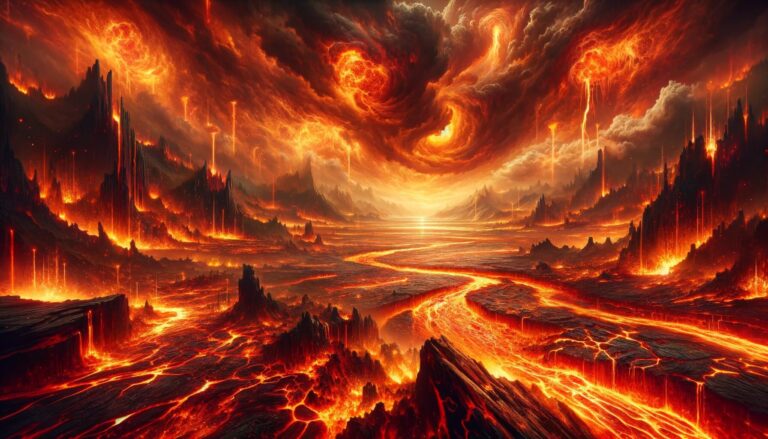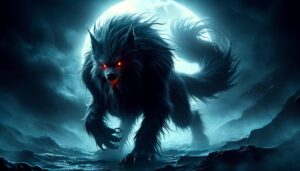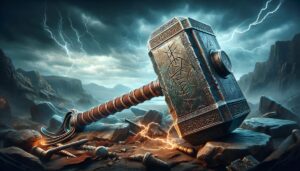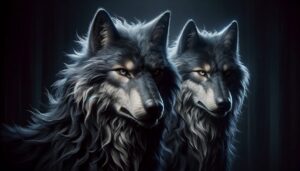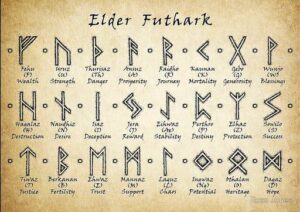Table of Contents
In the rich tapestry of Norse mythology, Muspelheim stands as a realm of awe and dread, a land shrouded in flames and inhabited by fierce and enigmatic beings. Known as one of the Nine Worlds, Muspelheim is the primordial land of fire, heat, and chaos. This fiery realm plays a pivotal role in the cosmic order of Norse mythology, and its inhabitants, including the mighty fire giant Surtr, wield tremendous power that threatens the very existence of the cosmos.
Origins and Existence
Muspelheim is one of the two primordial realms that existed before the creation of the cosmos as we know it. The other is Niflheim, the icy realm. These two opposing forces came into being before anything else and eventually collided, giving birth to the cosmos. Muspelheim’s fiery nature opposes the icy coldness of Niflheim, and their collision ignited the creation of the first being, Ymir, from whose body the world formed.
Inhabitants and Hierarchy
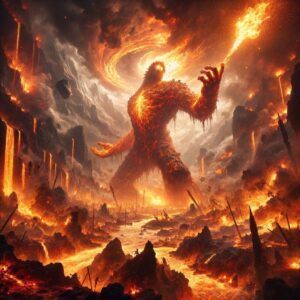
At the heart of Muspelheim resides Surtr, the Fire Giant King, a colossal and menacing figure. He is often described as having a body of flames and wielding a flaming sword of immense power. Surtr is prophesied to play a pivotal role during Ragnarök, the apocalyptic battle that will ultimately lead to the destruction and rebirth of the world.
Surtr’s minions and subjects are the Fire Giants, powerful and malevolent beings made of living flame. Furthermore, these creatures are destructive by nature and are known for their fiery tempers and insatiable thirst for chaos and destruction. Amidst the blazing landscapes of Muspelheim, they dwell, tirelessly forging weapons and plotting the eventual demise of the cosmos.
Appearance and Environment
Muspelheim is a realm characterized by its intense and unrelenting heat. It is a land of perpetual flames, molten rivers, and volcanic eruptions. The skies are ablaze with fiery storms, and the very air seems to shimmer with the heat. The ground is treacherous, with scorching lava flows and jagged rocks that make it nearly impossible for outsiders to traverse.
The landscape of Muspelheim is a paradoxical blend of barren desolation and vibrant, otherworldly beauty. Despite its harshness, there is a certain mesmerizing allure to the realm’s fiery vistas and the dancing flames that play across the horizon.
Who Ever Entered?
In Norse mythology, gods or heroes entering Muspelheim are rare due to its inhospitable and dangerous nature. Muspelheim, the fiery realm inhabited by the fiery Fire Giants, is primarily depicted this way, discouraging most beings from approaching.
An exception emerges in the figure of Thor, the god of thunder. Some versions of Norse myths prophesy Thor’s inevitable confrontation with Surtr, the Fire Giant, during the cataclysmic battle of Ragnarök, set in Muspelheim. While not a voluntary visit, this prophecy implies Thor will enter Muspelheim as part of the apocalyptic events foretold in Norse mythology.
In summary, Muspelheim remains primarily associated with the Fire Giants and their fiery domain, seldom visited by gods or heroes in Norse myths.
Abilities and Powers
The fiery inhabitants of Muspelheim possess formidable abilities related to their element. Fire Giants, including Surtr, can manipulate fire at will, conjuring flames that can scorch even the mightiest foes. Surtr’s sword is a weapon of unparalleled destruction, capa
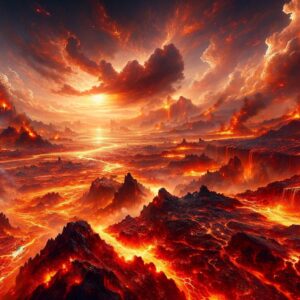
ble of setting the very fabric of the cosmos ablaze.
In addition to their mastery of fire, the denizens of Muspelheim are immune to extreme heat and fire-based attacks. They draw their strength from the fiery realm itself, making them formidable adversaries for any who dare to challenge them.
Symbols and Representations
Norse art and symbolism often portray Muspelheim as a realm engulfed in flames, with Surtr at its center, brandishing his fiery sword. The symbol of Muspelheim serves as a stark contrast to the imagery associated with other realms, such as the icy landscapes of Niflheim or the lush, fertile plains of Midgard.
Related Myths and Stories
The Creation Myth
In the creation myth of the Norse cosmos, the fiery realm of Muspelheim and the icy forces of Niflheim collided in a cataclysmic clash. Consequently, this momentous collision set in motion the very creation of the world we know. From the fiery chaos of Muspelheim and the frigid void of Niflheim emerged the primordial being known as Ymir.
As the fire and ice intertwined, rivers of molten heat flowed alongside freezing rivers of ice. Additionally, drops of water formed from the melting ice, and from these droplets, Ymir took shape. He was the first and most ancient being, a giant of immense proportions, born from the fusion of these opposing elements.
Ymir’s existence marked the beginning of the cosmos. Furthermore, he was the progenitor of all subsequent life in Norse mythology. From his body, the gods themselves were born, as Ymir’s sweat turned into the race of giants, and his flesh and bones became the earth and mountains. Even the seas and oceans were formed from his blood.
This tumultuous birth of Ymir and the subsequent creation of the world exemplify the dynamic and ever-changing nature of the Norse cosmos. Here, elemental forces and divine beings played crucial roles in shaping the intricate tapestry of existence.
The Prose Edda
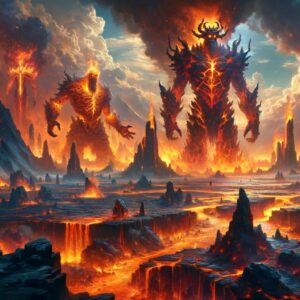
Muspelheim assumes a crucial role in various Norse myths and prophecies, particularly in the Prose Edda, where a momentous foretelling unfolds. This prophecy predicts that the formidable Fire Giant, Surtr, will lead his fiery brethren in an apocalyptic battle against the gods during the cataclysmic event known as Ragnarök.
This fateful conflict will disrupt the cosmic order itself, resulting in the complete destruction of the entire cosmos. However, the Norse belief system features cycles of creation and destruction, and even amid this chaos, a glimmer of hope arises.
For from the ashes of this apocalyptic clash, the world will be reborn anew, rejuvenated and revitalized. The tale of Muspelheim’s role in Ragnarök underscores the cyclical nature of Norse mythology, where the forces of destruction ultimately pave the way for a fresh beginning, ensuring that the cosmic drama endures throughout eternity.
Similar Creatures and Realms
While Muspelheim is unique in Norse mythology due to its fiery nature, other mythologies have realms and creatures that share some similarities.
This prophecy dictates that the formidable Fire Giant Surtr will lead his fiery brethren in an apocalyptic battle against the gods during the cataclysmic event known as Ragnarök.
During this fateful conflict, the cosmic order itself will disrupt, resulting in the utter destruction of the entire cosmos. Nevertheless, the Norse belief system, characterized by cycles of creation and destruction, allows a glimmer of hope to emerge even amid this chaos.
While not a realm of chaos and destruction like Muspelheim, Agni’s fiery nature represents a different aspect of fire within the Hindu cosmology.
In conclusion, Muspelheim is a realm of intense heat, chaos, and fire in Norse mythology. Its inhabitants, the Fire Giants, led by the fearsome Surtr, pose a constant threat to the stability of the cosmos. Muspelheim’s fiery landscape, its role in the creation myth, and its prophesied involvement in Ragnarök make it a significant and formidable part of Norse mythology, a realm where the very essence of fire and destruction holds sway.
FAQ
Who are the inhabitants of Muspelheim?
The main inhabitants of Muspelheim are the Fire Giants, powerful beings made of living flame. Surtr, the Fire Giant King, is their formidable leader.
What is Muspelheim's role in Norse mythology?
Muspelheim plays a pivotal role in Norse mythology as the fiery realm associated with destruction and chaos. It is prophesied to be a central battleground during Ragnarök, the apocalyptic event.
Are there any gods or heroes who ventured into Muspelheim?
Very few accounts mention gods or heroes entering Muspelheim due to its hostile nature. Thor is an exception, as he is prophesied to confront Surtr during Ragnarök.
How does Muspelheim relate to the creation of the cosmos?
Muspelheim and Niflheim, the icy realm, collided in the primordial void, giving birth to Ymir, the first being. Ymir's body was used to form the world.
What symbols represent Muspelheim?
In Norse art and symbolism, Muspelheim is often depicted as a realm engulfed in flames, with Surtr brandishing his fiery sword.
Is there hope amid Muspelheim's fiery chaos?
Yes, despite its destructive nature, Norse mythology embraces cycles of creation and destruction. From the chaos of Ragnarök, a new world is destined to be born.
How does Muspelheim compare to other realms in Norse mythology?
Muspelheim stands in stark contrast to realms like Niflheim (the realm of ice) and Midgard (the world of humans), emphasizing the diverse and dynamic nature of Norse cosmology.
